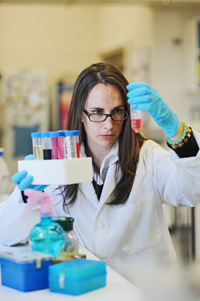Study on ageing goes beyond skin-deep
12 December 2012 Skin deep: Master's graduate Victoria van Kets' research looked at the cells in the dermal layer of the skin (fibroblasts) and their reactions to photodynamic therapy.
Skin deep: Master's graduate Victoria van Kets' research looked at the cells in the dermal layer of the skin (fibroblasts) and their reactions to photodynamic therapy.
They say only mad dogs and Englishmen go out in the midday sun. These days, though, exposure to the sun at any time incurs the risk of skin ageing and even cancer.
Victoria van Kets, who is graduating with an MSc in medicine, specialising in cell biology, says skin ageing is mainly a result of regular sun exposure, which - although it is only noticeable after many years - is irreversible without intervention.
It can also lead to more serious health issues, such as skin cancer.
"The biggest fallacy," she says, "is to think that someone is immune to the sun's harmful rays because they 'tan easily', 'never burn' or have a darker skin tone. A healthy diet and lifestyle play a major role in how a person's skin ages, but stopping the acceleration of skin ageing, and preventing the possible development of skin cancer, is simple: avoid the sun as much as possible."
Van Kets' research project looked at the cells in the dermal layer of the skin (fibroblasts) and their reactions to a treatment called photodynamic therapy. This was originally used to treat non-melanotic skin cancers, and was found to cause a significant improvement in the overall appearance of the skin. This therapy involves the use of a chemical that absorbs a specific wavelength of light, delivered by a laser, to create transient reactive molecules believed to modulate cell signalling.
"The main issue with the treatments available for skin ageing are the variable responses of each individual to a (particular) therapy. Right now, there is no 'gold standard' to treat all types of skin ageing for every person - that would be the golden ticket to the Willy Wonka chocolate factory."
"My research focused on non-invasive therapies using lasers, which are gaining momentum as a treatment as they are relatively easy to perform; there is little or no downtime and the results are successful - albeit more subtle than surgery or chemical peels, which have the potential for serious side-effects.
"The products in development to treat skin ageing are moving towards targeting the molecular mechanisms of the cell. This way they have the potential to reduce the appearance of wrinkles or unsightly pigmentation from inside the cell. However, it may take a while before these products are available to the general public, as research and development will take time to ensure the predicted outcomes are true and there are no bad side effects."
Lasers, she says, "have the amazing ability to emit light of a specific wavelength with a certain power or energy. They are widely used in medicine and science due to the ability of molecules with a certain chemical structure to absorb a specific wavelength of light. This absorption can lead to many outcomes, one of which is the creation of reactive molecules able to transfer the absorbed light energy to other, nearby molecules or systems."
 This work is licensed under a Creative Commons Attribution-NoDerivatives 4.0 International License.
This work is licensed under a Creative Commons Attribution-NoDerivatives 4.0 International License.
Please view the republishing articles page for more information.







